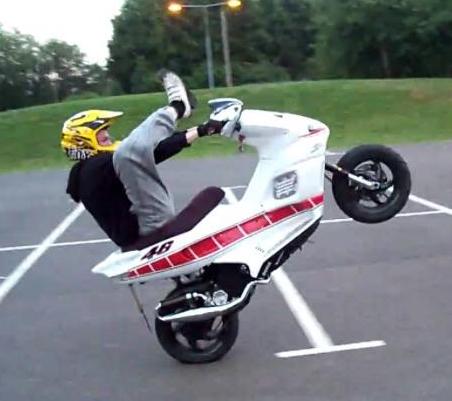As I’m sure you’re aware, the scooter market often adopts the trickle down of technology from motorcycle racing.
Over the year scooters have taken up fuel injection, water cooling, anti lock braking, traction control to the rear wheel (which also acts as a form of wheelie control), dual compound tyres, bluetooth communications via the instrumentation to the rider and recently we’ve spotted radar assisted braking systems and even lane correction systems being sprooked.
With this in mind, we read that Ducati launched a Supermotard motorcycle that has a wheelie assist system.
Yes that’s pretty much as it reads. The system, rather than preventing wheelies, allows the rider to maintain a wheelie for much longer.
It’s an interesting bit of tech, as it would trigger a cut in torque using the same methods we currently use in traction control you find on popular scooters like the Vespa GTS 300 and others, by altering the ignition, injection, throttle position, or a combination of all three.
The development of the six-axis inertial measurement unit (IMU), which started to reach production bikes around a decade ago, is key to the much more sophisticated wheelie control motorcycles use now.
Based on Micro Electro-Mechanical Systems (MEMS), these IMUs were pioneered by Bosch who work closely with Ducati and scooter companies like Vespa, Piaggio and Aprilia.
MEMS blur the distinction between mechanical and electronic elements, with microscopic movement sensors and gyroscopes mounted inside chip-like components on circuit boards.
They’re how your phone can tell what angle it’s being held at and whether it needs to rotate the screen image and can just as easily measure the angle and rate of angle change of a two wheeled machine.
From what we read, the Ducati system allow 3 or 4 levels of assistance and provides the rider to control wheelie height and length.
Naturally, they don’t recommend this for road use, and only offer the package along with a non street legal exhaust kit.
This having been said, this won’t prevent scooter hoons licking their lips at the thought, as many modern scooters already have wheel sensors and other equipment fitted that would be need to make this plausible on a scooter.
At the moment, for Ducati Supermotard owners, the system and exhaust will cost you around an extra $5000, so its well out of reach for us at the moment.
Having said that, we also thought dual compound tyres were an exotic thing that only MotoGP teams could afford, and now we fit them here at the shop on a daily basis to many scooters for similar cost to a single compound tyre.
While wheelie assist will never come as a standard feature on most scooters, it’s always interesting to see what technology is available and how it can help improve riders experience.

